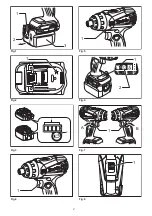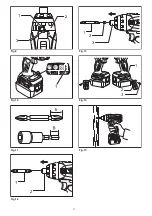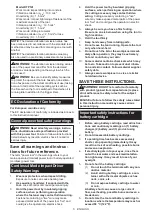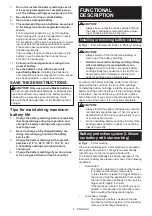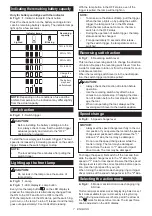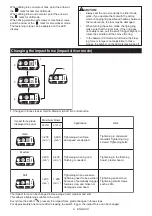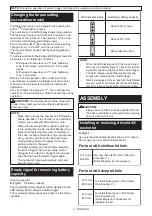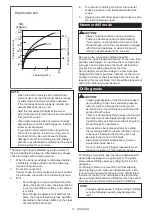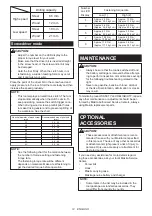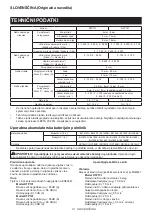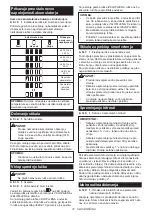
11 ENGLISH
120
100
80
60
40
20
High tensile bolt
N m
Fastening torque
Fastening time
Proper fastening torque
(kgf cm)
(1,224)
(1,020)
(816)
(612)
(408)
(204)
(S)
0
1.0
2.0
3.0
(M12)
(M10)
(M8)
0
M12
M10
M8
NOTE:
•
When the action mode is set to impact driver
mode, make sure that the tool impacts properly
by fastening a wood screw before operation.
If the tool does not work properly, contact your
nearest Makita service center.
•
Hold the tool pointed straight at the screw.
•
Use the proper bit for the head of the screw/bolt
that you wish to use.
•
When fastening screw M8 or smaller, carefully
adjust pressure on the switch trigger so that the
screw is not damaged.
•
If you tighten the screw for a time longer than
shown in the figures, the screw or the point of
the driver bit may be overstressed, stripped,
damaged, etc. Before starting your job, always
perform a test operation to determine the proper
fastening time for your screw.
The fastening torque is affected by a wide variety of
factors including the following. After fastening, always
check the torque with a torque wrench.
1. When the battery cartridge is discharged almost
completely, voltage will drop and the fastening
torque will be reduced.
2.
Driver bit or socket bit
Failure to use the correct size driver bit or socket
bit will cause a reduction in the fastening torque.
3. Bolt
•
Even though the torque coefficient and the
class of bolt are the same, the proper fasten-
ing torque will differ according to the diame-
ter of bolt.
•
Even though the diameters of bolts are the
same, the proper fastening torque will differ
according to the torque coefficient, the class
of bolt and the bolt length.
4.
The manner of holding the tool or the material
of driving position to be fastened will affect the
torque.
5.
Operating the tool at low speed will cause a reduc-
tion in the fastening torque.
Hammer drill mode
CAUTION:
•
Always hold the tool firmly during operation.
There is a tremendous and sudden twisting
force exerted on the tool/bit at the time of hole
break-through, when the hole becomes clogged
with chips and particles, or when striking rein-
forcing rods embedded in the concrete.
Be sure to use a tungsten-carbide tipped bit.
Position the bit at the desired location for the hole, then
pull the switch trigger. Do not force the tool. Light pres-
sure gives best results. Keep the tool in position and
prevent it from slipping away from the hole.
Do not apply more pressure when the hole becomes
clogged with chips or particles. Instead, run the tool at
an idle, then remove the bit partially from the hole. By
repeating this several times, the hole will be cleaned out
and normal drilling may be resumed.
Drilling mode
CAUTION:
•
Pressing excessively on the tool will not speed
up the drilling. In fact, this excessive pressure
will only serve to damage the tip of your bit,
decrease the tool performance and shorten the
service life of the tool.
•
There is a tremendous force exerted on the tool/
bit at the time of hole break through. Hold the
tool firmly and exert care when the bit begins to
break through the workpiece.
•
A stuck bit can be removed simply by setting
the reversing switch to reverse rotation in order
to back out. However, the tool may back out
abruptly if you do not hold it firmly.
•
Always secure small workpieces in a vise or
similar hold-down device.
•
Do not pull the switch trigger repeatedly when
the motor is locked. It may damage the tool.
For drilling in wood, the best results are obtained with
wood drills equipped with a guide screw. The guide
screw makes drilling easier by pulling the bit into the
workpiece.
For drilling in metal, to prevent the bit from slipping
when starting a hole, make an indentation with a cen-
ter-punch and hammer at the point to be drilled. Place
the point of the bit in the indentation and start drilling.
Use a cutting lubricant when drilling metals. The excep-
tions are iron and brass which should be drilled dry.
NOTE:
•
Choose suitable speed for the work load. Drilling
over the following capacity may damage the
tool.


